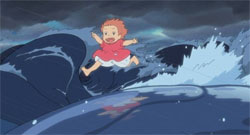The magic of Hayao Miyazaki is impossible to describe in a straightforward plot summary. I can only write “magic” or “bowl of delights” so many times, and it won’t really give you a feel of what a delight Ponyo truly is. I could say “surprisingly delightful,” but if you are familiar with Miyazaki’s work, you’ll know he excels at creating just such magical worlds of wonder. For the uninitiated, permit me to describe the opening scene:
A Japanese David Bowie, with a little too much rouge on his sallow cheeks—which, though perfectly in keeping with the ostentation of his garishly pinstriped suit and lion-mane of hair, still makes him look a bit like a transvestite—perches above his four-limbed submarine, deep in the ocean. This is an ocean of a child’s dream, or a hippie’s psychedelic nightmare, where jellyfish and the rest of the ocean’s denizens sprout and pop everywhere.
A fish with a human face peeks out of the submarine and flees. Tucking herself under one jellyfish (as a duvet), and napping along the way, the as-yet-unnamed character rides a larger jellyfish to the surface. Cue the opening credits.
Did I mention this scene takes place in silence? Don’t worry, the key details are filled in later. The fish, named Ponyo (Noah Cyrus) by a boy (Frankie Jonas) who plucks her from the ocean, is escaping her wizard father (Liam Neeson), and finds love with the boy who rescued her. At the same time, however, the plot details don’t really matter. The story is simple—taking its cues from Hans Christian Anderson’s The Little Mermaid and avoiding the Disney ridiculousness (more on that later)—but it is told with such enthusiasm and joy, the kinds that only a child can muster.
And truly, Miyazaki’s latest film is more like a story told by a child than a film for children. This point is emphasized by its striking and unusual visuals—all bright colors and hand-drawn animation—that, through all of the ostentation, make the working-class seaside of Japan, where the boy lives and Ponyo ends up, feel vividly alive.
Ponyo lacks the narrative force of earlier films by Miyazaki, but it makes up for it with pure, unadulterated whimsy. The darker Princess Mononoke and Howl’s Moving Castle place conflict at the center of their stories, which have a more militaristic tinge. Ponyo is dark, but only to the limits of a child’s imagination. A great flood that overtakes the town much later in the film isn’t supposed to be reminiscent of Hurricane Katrina; the flood instead illustrates the delightful possibilities arising though transformation of the ordinary. We have, by this time, seen the town and the countryside on a normal workday—and so we feel the same sense of wonder that the children feel when, suddenly, fish are living in the boy’s yard!
Ponyo is packed full of such small delightful moments. It’s a shame when the film’s charms are overshadowed by the film’s most glaring weakness—dubbing into English. I don’t know if the dialogue was too literally translated, or if the localizing team was more intent on matching words to the characters’ original mouth movements, but the final product is awkward at times. And wait a minute, David Bowie-san is Liam Niesson? Tina Fey, Matt Damon, Lily Tomlin, Cloris Leachman, Betty White, Cate Blanchett? What are you doing in Japan? Too much starpower occasionally overwhelms this modest and understated movie.
But thankfully, it happens rarely. The horrific remix of the theme song is perhaps the most grating example. Sung by the voices of the leading characters, Cyrus and Jonas—the youngest of two sets of famous Disney siblings—the theme song is an auto-tuned abomination against music. But try to stop yourself from singing as you leave the theater, “Ponyo, Ponyo, Ponyo, tiny little fish / She’s a little fish from the deep blue sea.” It’s as simple as can be, just like childlike wonder—and just as joyous.

Photography courtesy IMDB.COM




